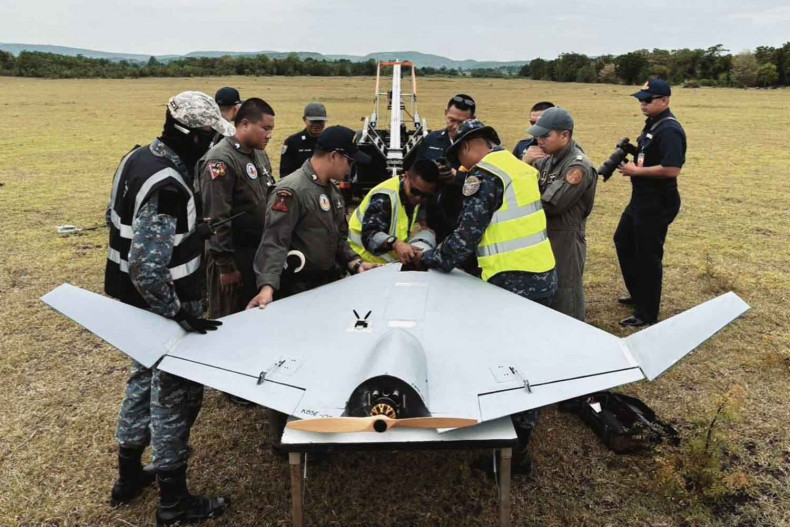Royal Thai Air Force Tests Locally Built Kamikaze Drone for Precision Strike Missions
During recent test trials, the drone reportedly achieved a targeting error of less than five meters, demonstrating precise strike capability against medium-range targets with its integrated high-explosive payload.
In a significant leap toward homegrown defence capabilities, the Royal Thai Air Force (RTAF) has publicly unveiled its first locally developed kamikaze kamikaze drone, a loitering munition designed to carry high-explosive warheads and neutralise high-value targets in combat zones.
The recently-unveiled locally developed kamikaze drone reflects Thailand’s growing commitment to defence self-reliance through indigenous innovation, according to a statement released by the RTAF.
The project, still unnamed, is the product of a strategic collaboration between the Navaminda Kasatriyadhiraj Royal Air Force Academy, the Directorate of Armament of the RTAF, and the RTAF’s Research and Development Centre for Space and Aeronautical Science and Technology.
During recent test trials, the drone reportedly achieved a targeting error of less than five meters, demonstrating precise strike capability against medium-range targets with its integrated high-explosive payload.
The RTAF praised the successful test as a major milestone in the roadmap toward full-scale production and operational fielding of the kamikaze drone, which is expected to significantly enhance Thailand’s combat readiness and sovereign defence capabilities.
“This achievement represents an important step in advancing the Kamikaze Drone program toward production and operational deployment,” the RTAF said in an official release.
“The system will increase our capability with advanced equipment to protect the nation’s sovereignty and ensure peace and security for the Thai people,” it added.

In a statement echoing Thailand’s broader defence doctrine of self-sufficiency, the RTAF noted, “National security cannot be bought with money – it must be created with your own hands.”
It further emphasized that, “The successful test results will allow plans for the system’s local production and fielding to move forward the strengthening of Thailand’s defence and indigenous defence industry capabilities.”
The Kamikaze Drone is launched via a catapult mechanism and features a delta-wing configuration powered by a combustion engine, which drives a rear-mounted pusher propeller.
The drone is controlled by a human operator via a radio link, using onboard electro-optical sensors to identify and acquire potential targets before initiating its final attack dive.
Designed specifically for one-way strike missions, the loitering munition cruises above the battlefield until a target is located, after which it is directed to crash into the objective, detonating its warhead with precision lethality.
While official specifications such as range, endurance, and payload weight remain undisclosed, defence observers suggest that the drone’s operational concept mirrors that of proven systems such as the Israeli Harop and Iranian Shahed-136, albeit in a locally tailored form.
This breakthrough comes at a time when sevearl Southeast Asian nations, are intensifying their investment in autonomous and loitering munitions to counter evolving battlefield threats and assert aerial dominance in contested regions.

The development aligns with Thailand’s recently articulated “Defence Industry Development Strategy,” which aims to reduce reliance on foreign arms suppliers and build indigenous competence across UAVs, cyberwarfare, and advanced munitions systems.
The RTAF’s emphasis on locally produced kamikaze drones also coincides with regional concerns over maritime security in the South China Sea, transnational terrorism in border regions, and asymmetric threats posed by grey-zone operations.
Analysts believe this Thai UAV program could serve as a stepping stone for future exportable loitering munitions tailored for ASEAN customers, particularly those seeking cost-effective alternatives to Western or Middle Eastern drone systems.
The emergence of a credible suicide drone capability from a Southeast Asian air force marks a pivotal shift in regional defence trends, where tactical UAVs are increasingly favoured over legacy systems due to their agility, lower operational cost, and capacity to deliver surgical strikes with minimal collateral damage.
In global terms, Thailand’s Kamikaze UAV entry reinforces the accelerating global shift toward expendable unmanned systems that blend surveillance, autonomy, and precision strike functionality in a compact, low-signature platform.
With rising geopolitical tensions and expanding grey-zone warfare tactics employed by state and non-state actors alike, kamikaze drones have proven decisive on battlefields from Ukraine to the Middle East—demonstrating their disruptive potential in modern warfare.
By investing in an indigenous program rather than procuring off-the-shelf loitering munitions from major suppliers like Israel or Turkey, Bangkok signals its ambition not just to deter but to lead in next-generation asymmetric aerial capabilities within the ASEAN bloc.
Though unarmed reconnaissance drones and fixed-wing UAVs have seen operational deployment in Thai service before, the introduction of a domestically built strike-capable suicide drone is a paradigm shift in the RTAF’s doctrine and posture.
If the Kamikaze Drone progresses to serial production and squadron-level deployment, it will represent the most advanced indigenous air-delivered munition in Thailand’s military inventory to date.
The combination of affordability, simplicity, and battlefield effectiveness makes loitering munitions an attractive solution for Thailand’s evolving threat matrix, including border skirmishes, narcotics interdiction, and counter-insurgency operations in the country’s southern provinces.
While questions remain about command-and-control integration, electronic counter-countermeasure resilience, and potential swarming capabilities, the RTAF’s successful trial is a promising indicator of what could evolve into a scalable, modular drone platform adaptable for future battlefield conditions.
The system’s low radar cross-section, ability to loiter, and one-way strike mechanism make it a perfect fit for high-risk, high-value missions without risking the lives of pilots or exposing manned aircraft.
As of now, the RTAF has not released visual footage or high-resolution imagery of the Kamikaze Drone in action, but internal sources suggest further testing, possibly including live-fire exercises against mobile targets, may occur before the end of the year.
If successful, this would place Thailand among a small but growing group of nations capable of independently designing, developing, and fielding lethal loitering munitions—a class of weapons once limited to technologically advanced militaries.
The RTAF’s Kamikaze Drone marks a watershed moment in Southeast Asia’s defence trajectory, one that may prompt neighbouring countries to accelerate their own UAV programs amid growing uncertainty and regional rivalries.
While the aircraft currently lacks a formal designation, its performance metrics and battlefield role already echo capabilities seen in some of the world’s most formidable drone arsenals.
In an age where aerial supremacy hinges on autonomy, speed, and strike precision, Thailand’s locally built suicide drone could emerge as a key enabler in reshaping the balance of military power across mainland Southeast Asia.
With production plans gaining momentum, the RTAF’s vision of a modern, self-reliant force equipped with indigenous precision strike assets may soon become a reality.
As drone warfare becomes increasingly decisive in conflict theatres across the globe, Thailand’s strategic bet on loitering munitions could position it as a technological leader in the region, while strengthening national security from within.


